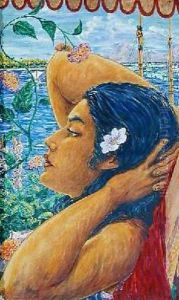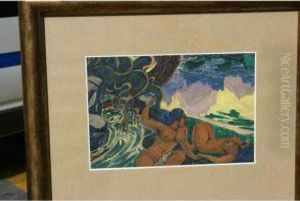Octave Morillot Paintings
Octave Morillot was a French painter and illustrator who was born on February 14, 1878, in Paris, France. He grew up in a time when the art world was undergoing significant changes, with the advent of new art movements such as Impressionism and Post-Impressionism. Morillot, however, was more influenced by the Symbolist movement, which sought to represent ideas and emotions through symbolic imagery and had a penchant for the exotic and the spiritual.
Morillot studied at the École des Beaux-Arts in Paris, which was the premier art institution in France at the time. He was a pupil of the famous painter and sculptor Jean-Léon Gérôme, who was known for his highly polished historical paintings. Under Gérôme's guidance, Morillot honed his technical skills and developed a keen eye for detail. He began to exhibit his works at the Salon des Artistes Français, a prestigious annual art exhibition in Paris, and gained some recognition for his talents.
In the early 20th century, Morillot's interests took him beyond the borders of France. He was particularly fascinated by North Africa and the Middle East, regions which provided a rich tapestry of visual inspiration for many European artists at the time. This fascination was in line with the Orientalist trend in European art, where artists sought to capture the perceived exoticism and mystery of the East. Morillot traveled extensively in these regions, and his experiences are reflected in his art, which often depicted scenes from daily life, landscapes, and portraits imbued with a sense of exoticism and an attention to the effects of light and color.
Morillot's works are characterized by their vibrant colors, strong compositions, and the ability to evoke a mood or atmosphere. Despite being a skilled painter, he never achieved the same level of fame as some of his contemporaries. His work was, however, appreciated by a circle of collectors and art enthusiasts who were drawn to his unique blend of realism and exoticism.
Octave Morillot's career was cut short by his untimely death on April 8, 1931, in Paris. Though he left behind a relatively small body of work, his paintings continue to be of interest to those studying the Orientalist movement and French art of the late 19th and early 20th centuries. Today, his works can be found in private collections and occasionally appear in auctions, offering glimpses into the artist's journey through the culturally rich landscapes that inspired him.

